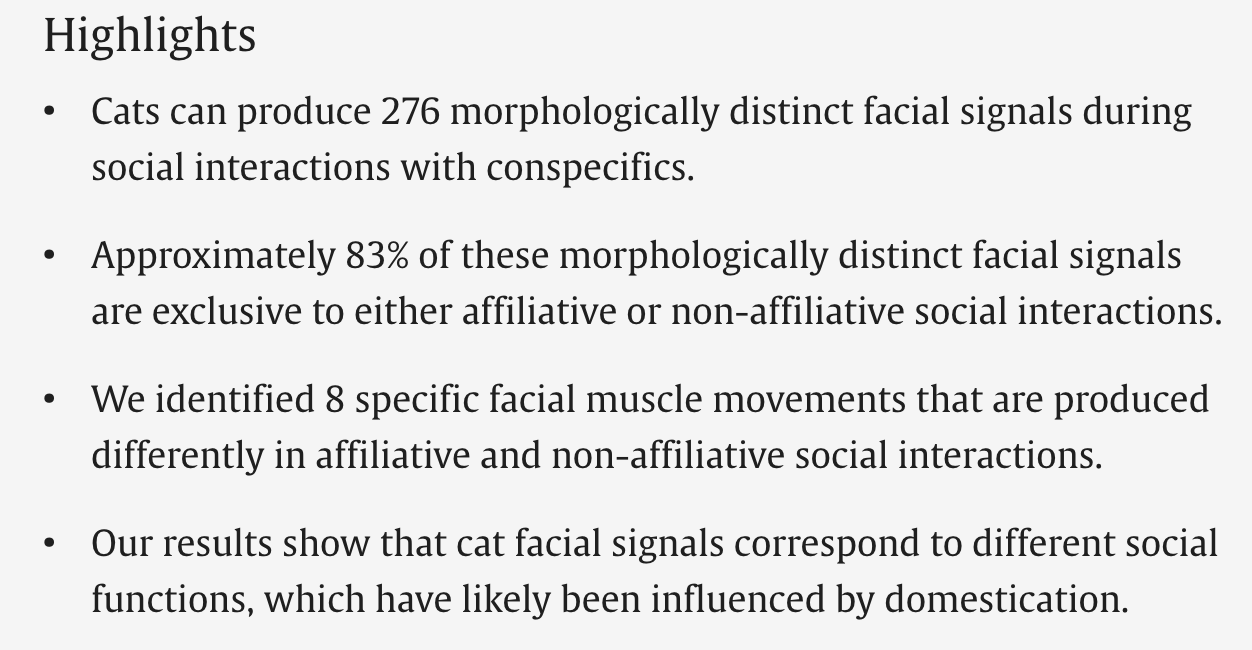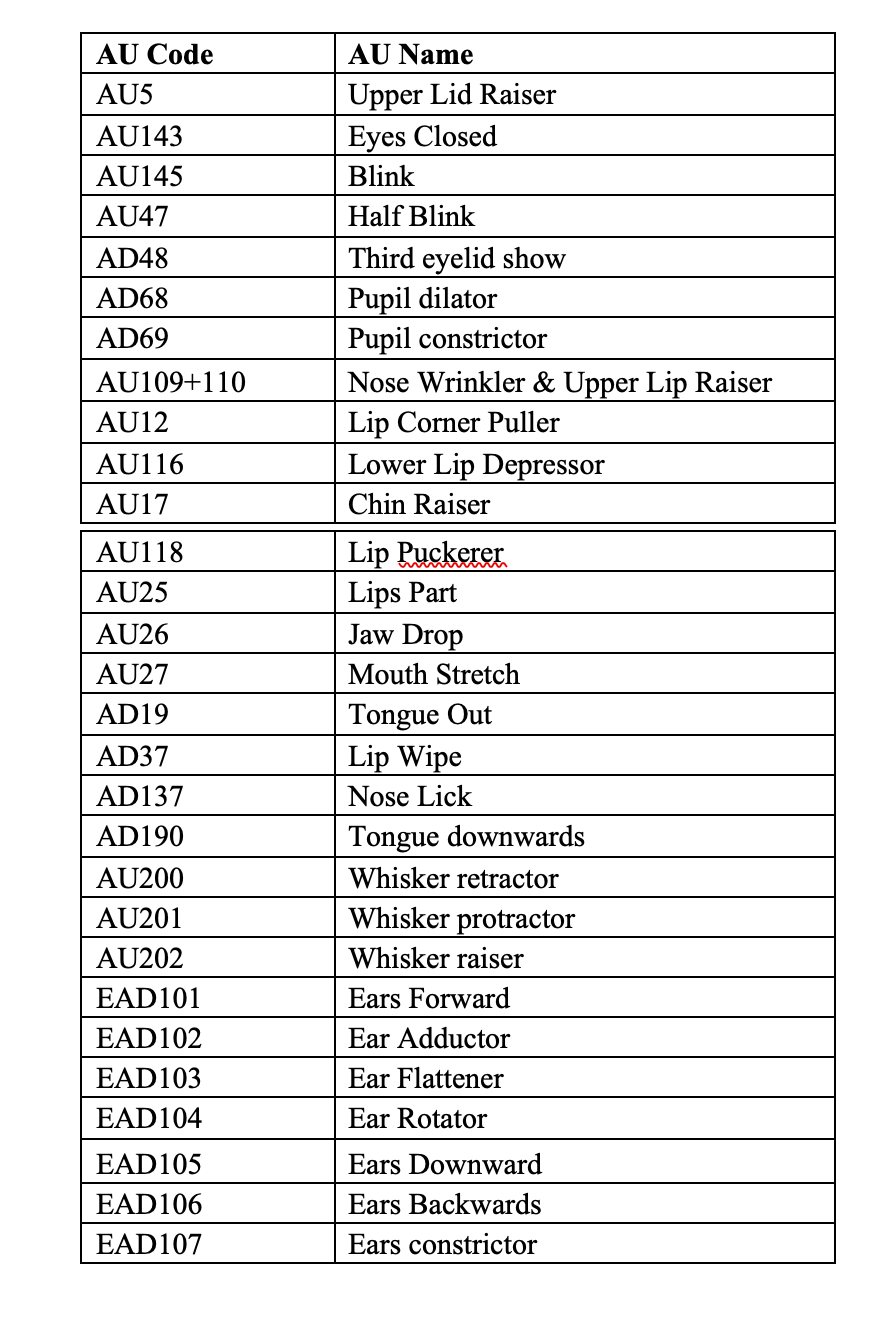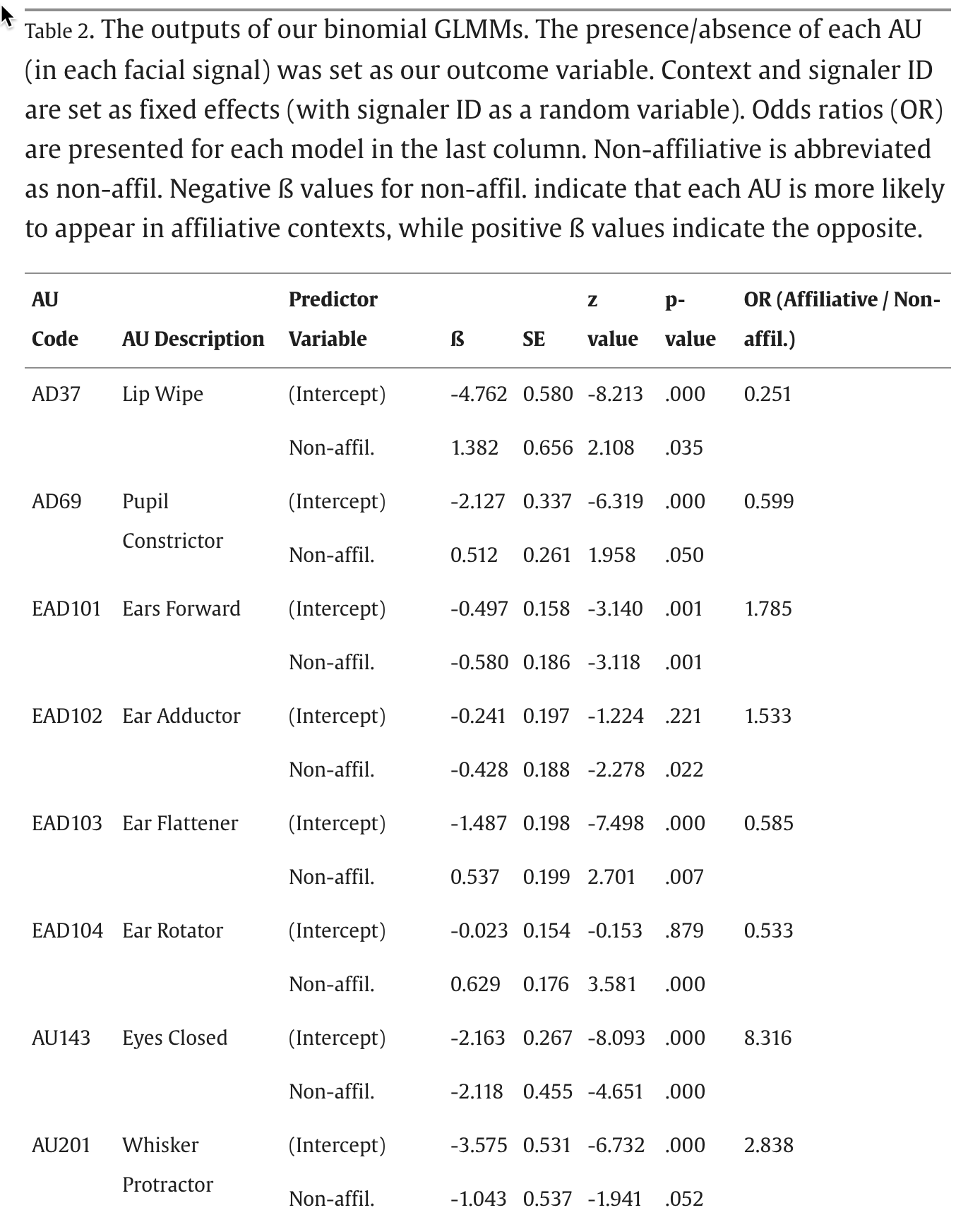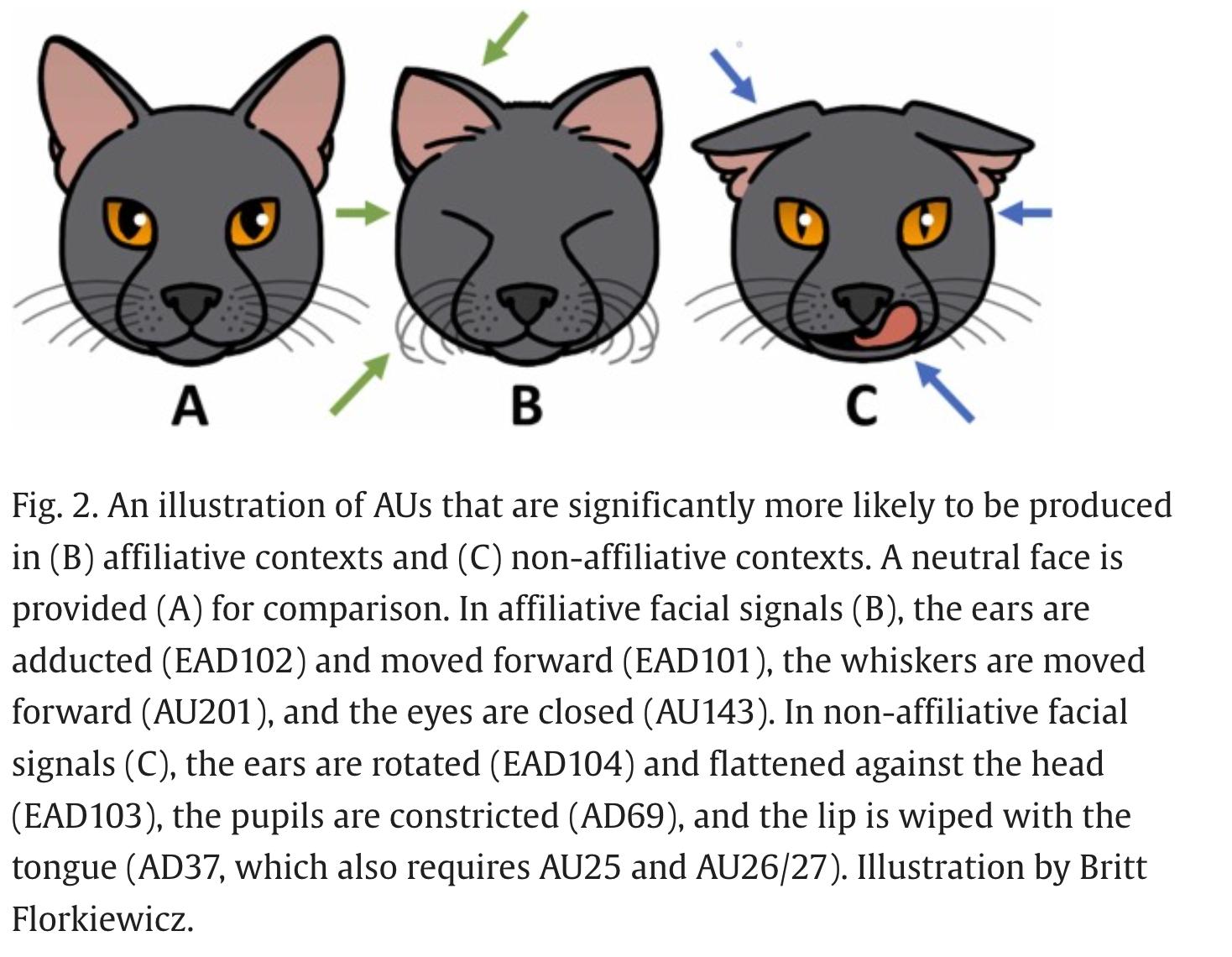276 cat facial expressions?
« previous post | next post »
Lauren Scott & Brittany Florkiewicz, "Feline Faces: Unraveling the Social Function of Domestic Cat Facial Signals", Behavioral Processes 2023:
ABSTRACT: Lately, there has been a growing interest in studying domestic cat facial signals, but most of this research has centered on signals produced during human-cat interactions or pain. The available research on intraspecific facial signaling with domesticated cats has largely focused on non-affiliative social interactions. However, the transition to intraspecific sociality through domestication could have resulted in a greater reliance on affiliative facial signals that aid with social bonding. Our study aimed to document the various facial signals that cats produce during affiliative and non-affiliative intraspecific interactions. Given the close relationship between the physical form and social function of mammalian facial signals, we predicted that affiliative and non-affiliative facial signals would have noticeable differences in their physical morphology. We observed the behavior of 53 adult domestic shorthair cats at CatCafé Lounge in Los Angeles, CA. Using Facial Action Coding Systems designed for cats, we compared the complexity and compositionality of facial signals produced in affiliative and non-affiliative contexts. To measure complexity and compositionality, we examined the number and types of facial muscle movements (AUs) observed in each signal. We found that compositionality, rather than complexity, was significantly associated with the social function of intraspecific facial signals. Our findings indicate that domestication likely had a significant impact on the development of intraspecific facial signaling repertoires in cats.
The associated science.org PR piece focuses on the count of facial-muscle "action unit" combinations that the experimenters tabulated: "Cats have nearly 300 facial expressions":
In a study published this month in Behavioural Processes, researchers tallied 276 different feline facial expressions, used to communicate hostile and friendly intent and everything in between.
And the first of the "Highlights" panel at the start of the Behavioural Processes article (added by the editors?) pushes the same point:
The 276/300 numbers had the predictable effect as click-bait (or click-bait bait?). And the research is certainly interesting, but it seems to me that the numerology is misleading.
What the experimenters did [links replaced for your convenience]:
[W]e assessed differences in the physical form of facial signals using Facial Action Coding Systems (or FACS) specifically designed for cats (catFACS; (Caeiro et al., 2017), 2013a). FACS are systematic and standardized tools for the study of human and non-human facial signals (Florkiewicz et al., 2023, Parr et al., 2010). Users are trained to identify subtle and overt facial muscle movements (which are referred to as action units or AUs) that are combined to create a signal (AU combination) (Ekman and Rosenberg, 2005).
According to Table S2 in their Supplementary Material, there were 29 "Action Units (AUs) that we considered in the present study":
They write:
Using the opportunistic sampling method, we were able to gather 194 minutes of video footage that featured 186 communicative events. In these communicative events, we coded 688 facial signals (413 that were produced by males and 275 by females). […]
Across 688 facial signals, we coded a total of 2,628 AUs.
And according to table S3, these 688 facial signals indeed involved 276 "AU Combinations", each combining up to 11 of the 29 "Action Units". (It's not clear to me whether the cap of 11 is empirical, practical, or random…)
That table also gives the number of times each combination was tallied — and unsurprisingly, a majority of the combinations were observed just once, suggesting that in a longer period of observation, somewhere between 276 and 29^11 = 1.220051e+16 distinct "Action Unit Combinations" might have been tallied.
And in the body of the article, they present as Table 2 a list of 8 Action Units with a statistically-significant affiliative/non-affiliative communicative value:
Their Figure 2 illustrates what this actually means:
So rather than "Cats have nearly 300 facial expressions", a more accurate count might have referred to the 8 Action Units that had significant affiliative/non-affiliative associations. Or the 2 communicative categories (affiliative/non-affiliative) whose signaling they analyzed.
It's good that there are (apparently reliable) catFACS, and that people are studying when, where, and how cats use them. No doubt cats have more to say for themselves than "let's (not) affiliate", and I'm looking forward to learning about those messages from future studies (which will also bring in communication via bodily motion, posture, and sound…).
The presentation and reception of this research is yet another example of Frank Luntz's observation that "It's not what you say, it's what people hear […] The act of speaking is not a conquest, but a surrender. When we open our mouths, we are sharing with the world — and the world invariably interprets, indeed sometimes shifts and distorts, our original meaning … Ultimately, it is the professional — the journalists, historians, and academics, who translate words into stories — who hold the key to language dissemination."
Or in this case, the editorial framers and PR professionals — if I'm right that they're the ones responsible for the "nearly 300" stuff. Sometimes scientists and engineers engage is this kind of puffery themselves, but that doesn't seem to be what happened here.




David L said,
November 12, 2023 @ 12:52 pm
Well, I dunno. A "facial expression" is presumably a distinct configuration of one or more muscular adjustments, whether in cats or people. And they found almost 300 of them, if I understand correctly.
I'm not sure how one would go about writing a press release to describe "8 Action Units that had significant affiliative/non-affiliative associations," or what the point would be. As a longtime observer of cats, what I notice are the facial expressions, not the individual elements that combine to create them. And facial expressions are the vehicle by which cats convey their state of mind to other cats or to people.
I like the phrase "opportunistic sampling method" in their methodology. Sounds sciencier than just saying they grabbed whatever kitty pix they could.
Philip Taylor said,
November 12, 2023 @ 1:01 pm
There was a spoof use of "opportunistic sampling method" (or more precisely a paraphrase thereof) in an article allegedly reporting on Jane [van Lawick] Goodall some 40 years ago. Rather than saying that she waited for some chimpanzee-related event to occur, it went into extraordinarily complex circumlocution to avoid using that simple word … If anyone can recall the exact wording used, I would be most interested to read it again.
Philip Taylor said,
November 13, 2023 @ 5:01 am
After some post-comment introspection, I am now reasonably certain that the spoof to which I referred above did not actually avoid the word "waiting". Rather, after considerable circumlocution (the exact words sadly escape me, but may have included the phrase "stimulus-free" or similar), the writer concludes « or, as we termed it, “waiting” », including the scare-quotes around “waiting”
Philip Taylor said,
November 13, 2023 @ 6:01 am
David — "facial expressions are the vehicle by which cats convey their state of mind" — might that not perhaps be more accurately expressed as "facial expressions are one of the vehicles by which cats convey their state of mind" ?
Benjamin Ernest Orsatti said,
November 13, 2023 @ 8:30 am
Philip,
True, given that "Give me canned food now" may be communicated by any number of mirthful and often painful forms of expression.
Peter Grubtal said,
November 13, 2023 @ 10:21 am
Have I missed something here, or is this an attempt at the Ig Nobel prize?
Benjamin E. Orsatti said,
November 13, 2023 @ 10:59 am
Peter,
No, you haven't missed anything, but lock up a group of zoologists for 2 years during COVID with only their cats for company…